Process Orchestration in 2025: A Beginner’s Guide
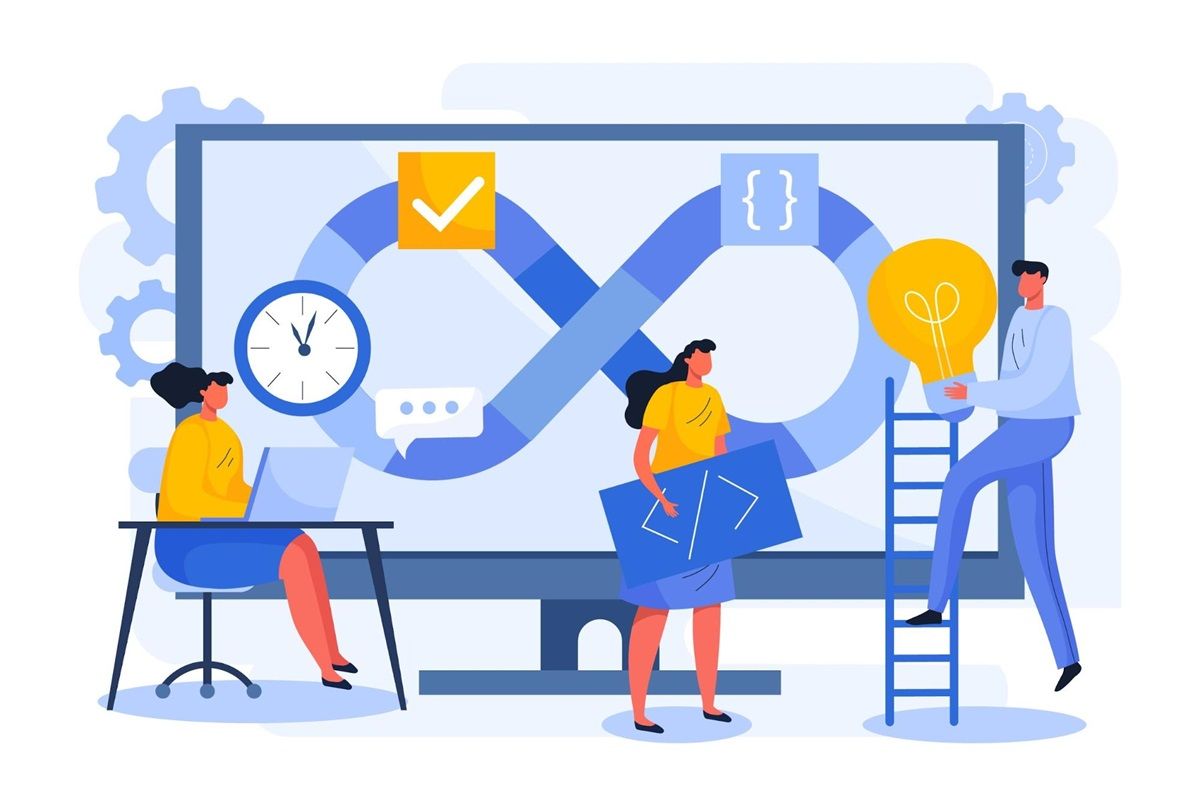
Process orchestration has become a top priority for many companies. As teams rely on multiple apps, people, and tasks, it’s easy for business operations to become messy and hard to control. When systems don’t connect, delays and errors slow everything down.
With process orchestration, you get a single way to organize these moving parts. It links human work, software, and automated steps into one clear flow. That means better oversight, faster results, and less stress for your team.
In this article, you’ll learn what process orchestration is and how it provides end-to-end visibility.
See how Activepieces fits your business by starting a free trial today!
What Is Process Orchestration?
Process orchestration refers to the coordination of people, apps, and systems so your work flows in the right order from start to finish.
Simple process automation handles one action at a time, but orchestration combines those actions with manual tasks and approvals into a complete flow. Connecting work across disparate systems creates cohesion where silos once slowed teams down.
Process orchestration works through a central hub that manages multiple systems, directs automated tasks, and records progress.
A universal process orchestrator guides actions across teams, integrates artificial intelligence for decision-making, and applies machine learning to spot delays before they grow.
In practice, this means that HR teams set up orchestration to onboard new hires by linking payroll, IT, and training.
Banks approve loans faster by coordinating credit checks, document reviews, and compliance.
Insurers manage claims by blending bots, AI tools, and human review. Each step connects to the next, so no piece falls through the cracks.
Overall, process orchestration acts as the conductor of complex workflows that tie together people and technology into one visible, reliable process.
How Does Process Orchestration Deliver End-to-End Visibility
With process orchestration, businesses and technical teams can both track how work moves, from routine steps to complex business processes.
The sequence below shows how an orchestration platform makes that possible:
- Map the workflow with visual tools so every step, task, and decision point is clear.
- Integrate existing apps, third-party services, and legacy tools into the same flow.
- Trigger each step in order, whether handled by a person or an automated system.
- Capture live updates in a central dashboard so progress can be tracked in real time.
- Send alerts when a task is delayed or fails so teams can act before problems spread.
- Collect logs that build a full audit trail across the entire process.
- Analyze performance with reports that highlight key performance indicators.
- Apply process orchestration platform features like analytics and AI to find patterns and improve efficiency over time.
Achieve End-to-End Workflow Visibility With Activepieces
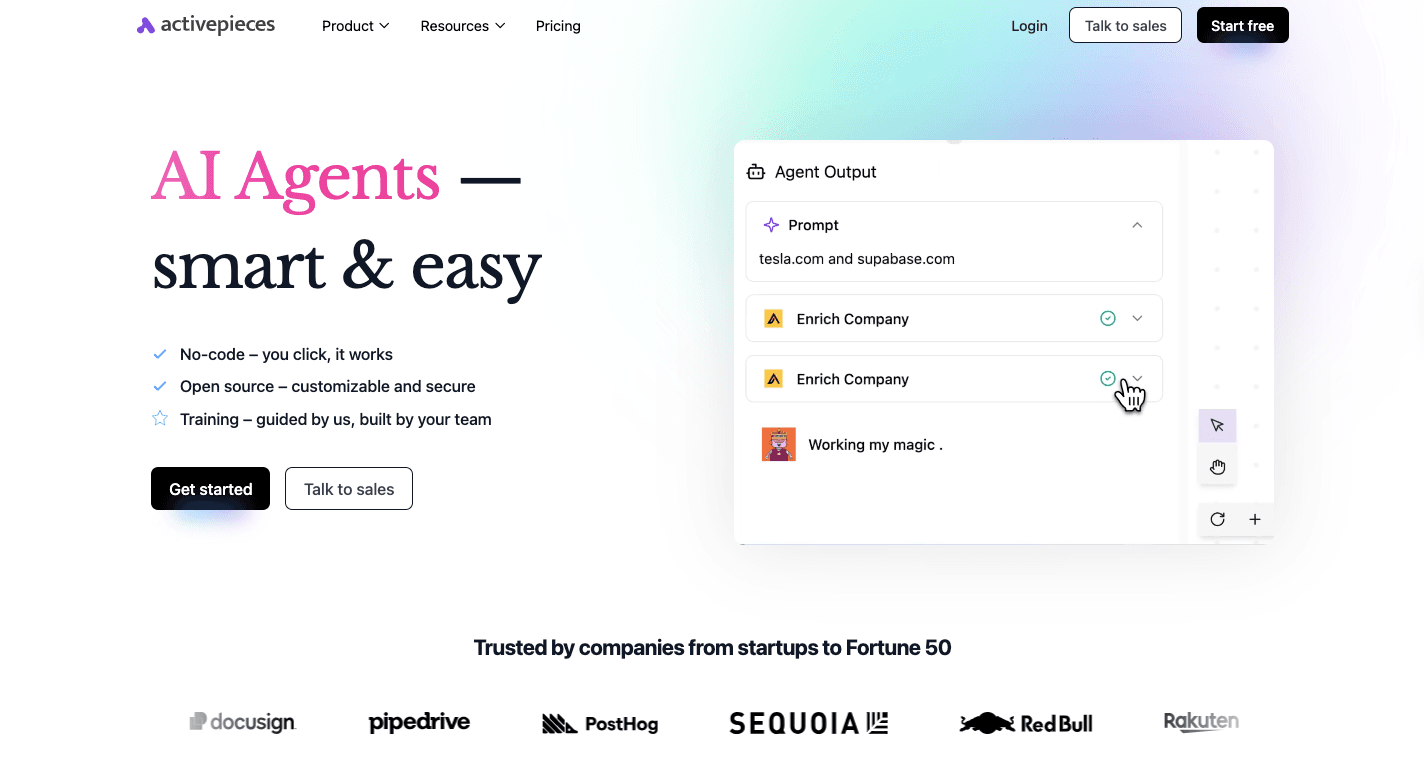
Activepieces works as an automation platform that connects apps, people, and data into one flow. Many process orchestration tools look complicated, but Activepieces makes everything easier. You can bring it into your existing workflows, which makes adoption easier for your teams that already depend on multiple systems.
For your non-technical users, they get a no-code builder, while developers extend the platform with TypeScript. The ecosystem is open too, which means the community adds new pieces every day, keeping the library fresh and relevant.
As of now, there are over 423 pre-built integrations, called pieces, and the number keeps growing. That steady growth helps cover mainstream apps and niche tools without delay.
Key Features
- User-friendly interface – Simple flow builder that both business and technical users can learn quickly.
- Open-source model – Code is transparent and community-driven, with over 423 pieces available.
- Automation templates – Pre-built workflows for common use cases that save time and reduce errors.
- AI-native design – Built-in support for AI providers and the ability to build custom agents with the SDK.
- Enterprise-ready setup – Strong access control, branding options, and secure deployment models.
- Flexible development – Pieces built in TypeScript with hot reload support.
- Human-in-loop options – Approval steps and input forms included as part of workflows.
- Integration depth – Connects to existing workflows and third-party apps without replacing current systems.
Integrations
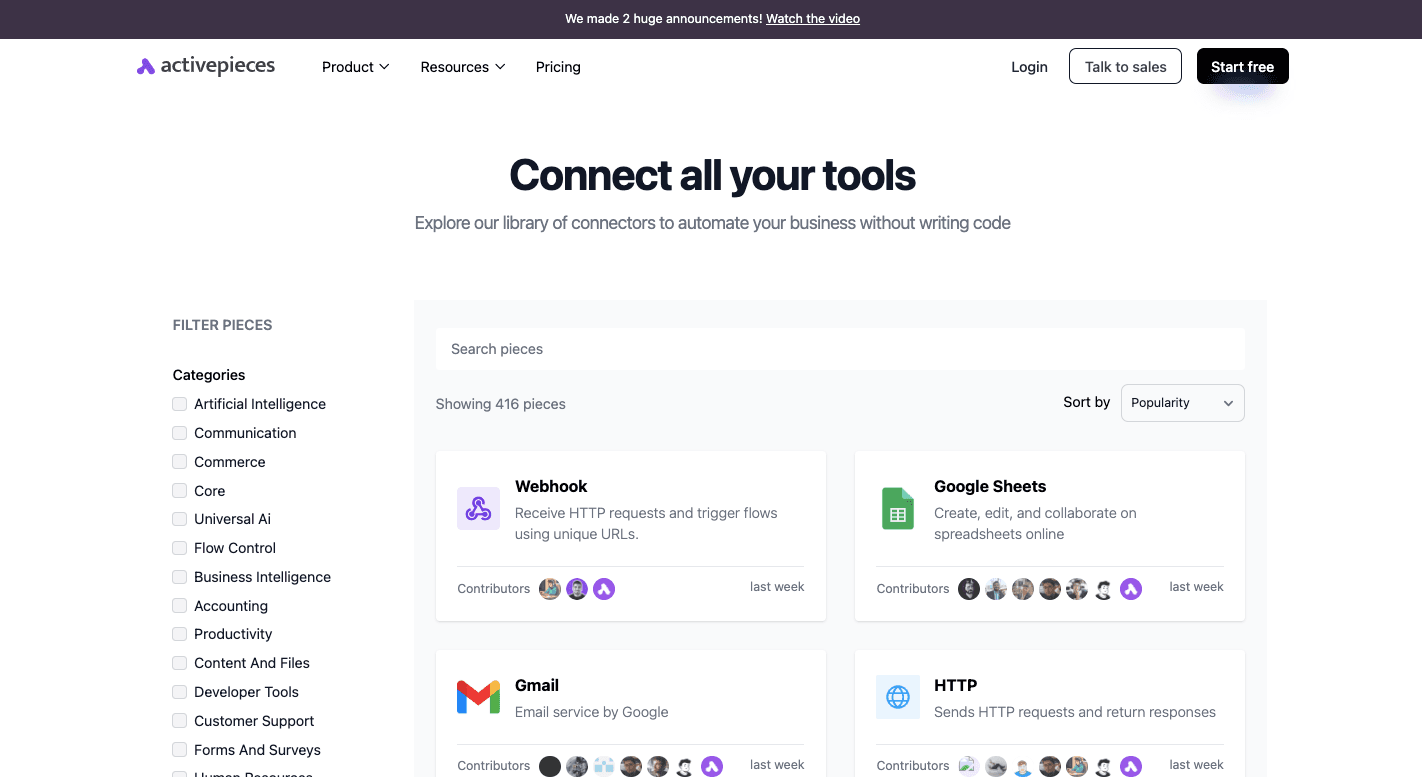
Activepieces offers over 423 pre-built integrations, covering a wide range of categories. These integrations, called “pieces,” allow companies to connect services without custom coding.
Some of the pieces you’ll get:
- Google Sheets
- Excel
- Slack
- ClickUp
- OpenAI
- Gmail
- ElevenLabs
- Zoho Desk
- Microsoft Dynamics CRM
- WordPress
- Zoho Invoice
The mix of community-built and developer-built pieces ensures quick growth. With support for legacy systems, third-party applications, and modern APIs, Activepieces becomes a natural fit for your existing workflows.
Use Cases
Activepieces helps you improve operations across multiple areas. Practical uses include:
- Automate employee onboarding by linking HR systems, IT setups, and approvals.
- Run marketing campaigns by connecting social media, email, and analytics tools.
- Speed up order fulfillment by linking inventory, billing, and shipping systems.
- Build AI-powered agents that manage support tickets or generate content.
- Integrate finance apps to handle invoices, reporting, and approvals automatically.
Pricing
Activepieces offers an open-source community edition that’s free and self-hosted. Cloud-hosted plans begin with a Free plan, which includes 1,000 tasks per month and access to AI features.
The Plus plan at $25 per month supports unlimited tasks under fair use, along with AI credits and more active flows. Then the Business plan at $150 per month expands capacity with 50 active flows, 1,000 AI credits, projects, and team access.
The Enterprise plan is custom and offers dedicated support with advanced options.
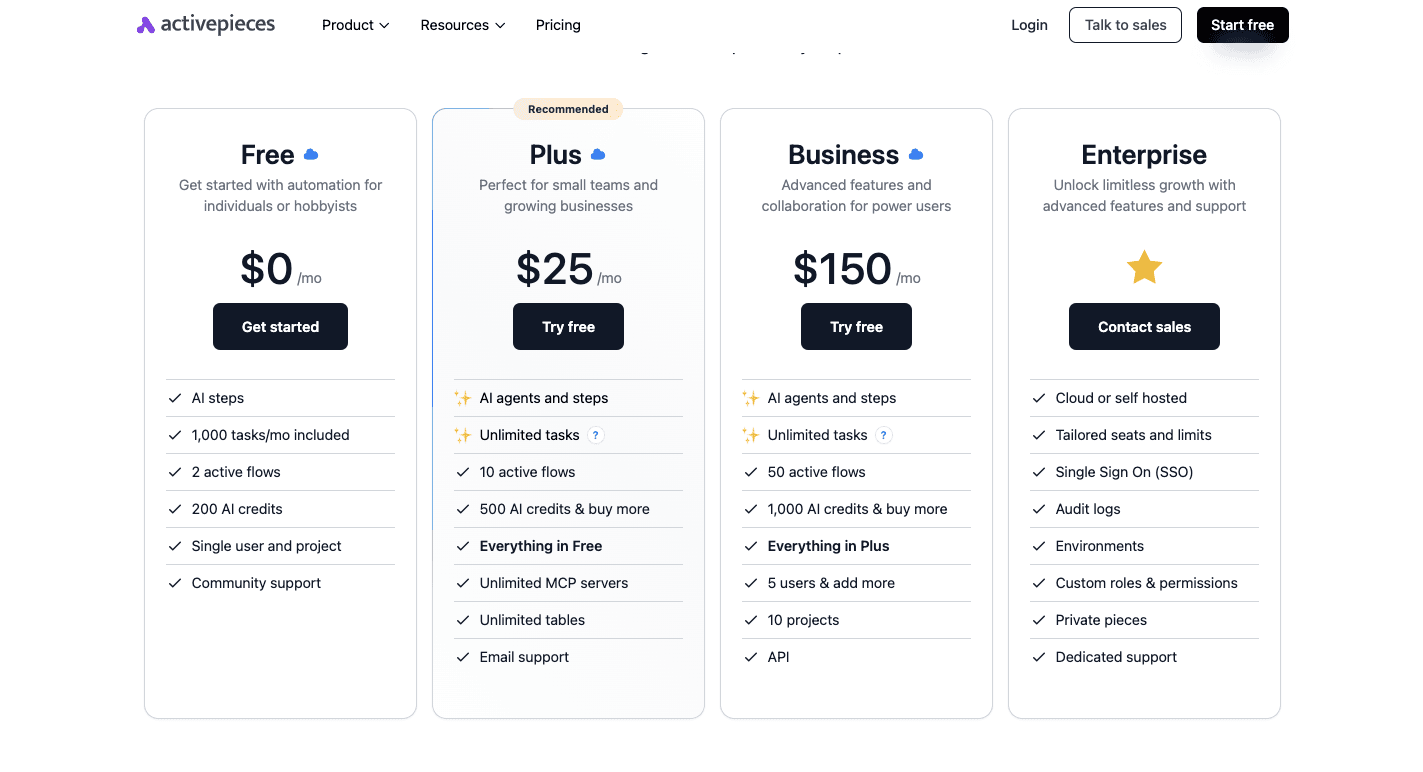
Compared to other automation platforms, Activepieces provides predictable flat-rate pricing, removing the cost spikes that come with task-based billing.
Reach out to sales today and discover custom Activepieces solutions for your team!
Process Orchestration vs. Related Concepts
Process orchestration handles full flows that bring people, apps, and systems together, while other methods focus on smaller parts. Some tools only manage individual tasks, but orchestration connects those steps into one end-to-end process.
Process Orchestration vs Task Automation
Task automation focuses on one action at a time, like sending a reset email or exporting a report. These small steps remove the need for manual data entry, but they remain isolated.
Automation tools do a great job at automating repetitive tasks, yet they don’t manage how those tasks connect to each other.
Process orchestration acts on a larger scale. It brings together automated tasks, human approvals, and app integrations so the entire flow runs as one. Not only does it fix one action, but orchestration directs how every step should happen and in what order.
For instance, an order-to-cash process. A script that sends an invoice is task automation. Orchestration coordinates the whole process:
- Checking inventory
- Creating the invoice
- Updating records
- Notifying shipping
Process Orchestration vs Business Process Management
Business process management (BPM) is the discipline you use to study and improve how work flows. It covers the entire cycle from design to monitoring and aims for steady process improvement.
Analysts use workflow management methods and process modeling to find gaps, remove delays, and keep work aligned with company goals. BPM involves business analysts and executives who want a better vision of how business process orchestration supports strategy.
Process orchestration sits inside this broader approach. It makes the blueprint real. Orchestration engines track execution, handle errors, and give teams visibility. Developers and technical staff focus on this layer to make sure work keeps moving.
Process Orchestration vs Workflow Automation
Workflow automation improves a single process inside one department. It handles repetitive processes and reduces human intervention in predictable tasks.
For example, mapping a sales workflow might involve an automatic invoice when a deal closes. These automated workflows streamline operations within that limited scope.
Process orchestration differs in reach. It manages complex processes that cross departments, apps, and people. Orchestration connects many workflows by using logic to adapt when conditions change, rather than focusing on just one.
A sandwich shop makes for a simple analogy. Workflow automation sends the order to the kitchen when payment is received. Orchestration manages the full chain:
- Order entry
- Inventory
- Prep
- Delivery
Process Orchestration vs Robotic Process Automation
Robotic process automation (RPA) uses bots to copy human actions like clicks and keystrokes. You can use it for repetitive jobs such as data entry in legacy apps without APIs.
Although process orchestration technology is helpful, bots alone can’t handle complex, end-to-end workflows.
Process orchestration directs tasks across systems, people, and automation tools. Orchestration routes approvals, calls APIs, and links bots with AI-driven checks.
Doing this supports digital transformation, where you want to modernize how work flows.
Benefits of Process Orchestration
Some of the main benefits of process orchestration include:
- Efficiency improves as automated steps run on time, and managers can see where tie-ups form.
- Costs drop since orchestration routes work to the right person, bot, or AI tool and raise overall operational efficiency.
- Teams streamline processes that once slowed down results and remove waste from daily work.
- Process orchestration ensures that your core business processes remain steady even as new systems or data are added.
- Employees move away from repetitive actions, which helps raise employee satisfaction and gives them more space for meaningful work.
Core Components of Successful Process Orchestration
A working orchestration system depends on several parts that handle design, execution, and oversight, such as:
Orchestration Engine
An orchestration engine acts like the central brain of process orchestration. It directs tasks, keeps order, and makes sure nothing is skipped.
When a process starts, the engine knows:
- Which step comes first
- Which can run in parallel
- What should wait until something else is finished
It can trigger a retry if a step fails or alert a person when a problem needs attention.
The engine keeps a record of everything, so you see which steps succeeded, which failed, and how long each one took. That history gives you insight into how work moves through the system.
With it, you gain orchestrated processes that connect people, apps, and bots into a clear sequence.
Integration Layer
An integration layer makes apps and databases work together, even when they were built on different standards. It supports legacy systems and third-party applications, so you don’t have to replace existing systems you already depend on.
The integration layer knows how to speak many “languages.” One app may use REST, another SOAP, and another message queues. The layer translates each into a common format so the orchestration engine can give clear commands.
For example, an order flow can use the integration layer to link the inventory system, billing service, and shipping provider. Each step runs in sequence, even though the systems were never designed to work with each other.
Business Rules and Logic
Business rules and logic guide decisions inside an orchestrated flow. The orchestration engine then calls on those rules when a choice needs to be made.
Rules can be simple, such as routing small orders straight to fulfillment, or more advanced, like checking credit scores and income before granting a loan. Having them in one system makes updates faster.
By adding business rules into automated processes, you create flows that respond to real data rather than following a fixed path.
Workflow Modeling
Workflow modeling is the stage where a process gets mapped before automation begins. You lay out the following so the orchestration engine knows how to run them:
- Each step
- Decision point
- Task
Many platforms now offer intuitive workflow design with drag-and-drop tools. You can use these to sketch how tasks move between people, apps, and bots. That makes collaboration faster and keeps technical teams from working in isolation.
Error paths get mapped here too. If an API call fails, the workflow can retry it or send the issue to an operator.
Monitoring and Analytics

Monitoring gives you visibility into how a process runs from start to finish. An effective system can track the entire process lifecycle, showing task status and progress in real time. That level of detail makes it easier to spot delays and act before they grow into bigger problems.
Dashboards highlight key performance indicators, such as:
- Completion times
- Error rates
- Throughput
Managers can compare these metrics against goals and see which steps need attention. Detailed logs also support root cause analysis that shows exactly where an issue began.
Mapping existing workflows helps create context for these metrics. You can compare before-and-after data to confirm that changes improved performance.
Over time, this cycle leads to continuous improvement, where each insight feeds back into the design of stronger workflows.
Error Handling and Recovery
Errors are part of any automated system, and recovery plans keep processes from stopping when something goes wrong. An orchestration platform can retry failed steps automatically, either at fixed intervals or with longer gaps between each attempt.
This approach keeps temporary issues, such as network glitches, from blocking the flow.
Not every failure is temporary, though. For those, fallback paths redirect work. If an automated inventory check fails, the system can send the task to a person for review. Compensation logic can also undo previous actions, such as refunding a payment if a later step fails.
Some issues require human intervention. The system creates a manual task and alerts the right team. These alerts reduce downtime and limit the impact of human errors.
Orchestrate AI Agents and Business Systems With Activepieces
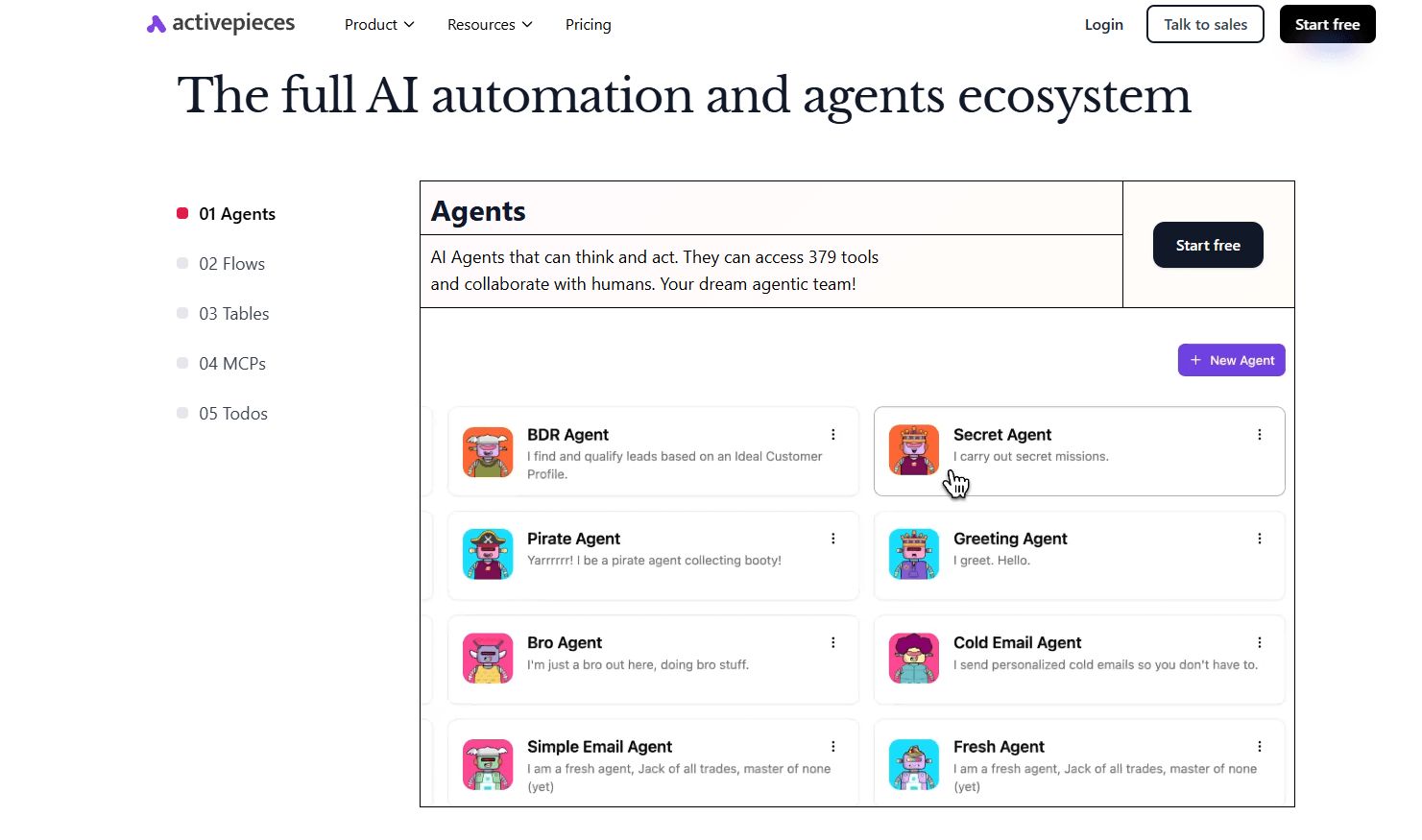
Activepieces makes it easy to connect AI agents with your everyday business systems. You can take routine work like sending emails, updating spreadsheets, or processing customer requests and tie it together with AI-driven logic.
The platform works as the control point that runs both automated tasks and AI decisions in the same flow. That combination helps reduce manual effort while making business operations smarter and more responsive.
You can apply Activepieces as an orchestration platform to handle complex business processes like onboarding, claims, or sales follow-ups.
Currently, there are 423 pieces available. The library keeps growing as the community adds new integrations. This steady expansion means you’re not limited to existing workflows.
With Activepieces, you can design new workflows that mix AI with business data and run them through a single hub.
Create your first automation flow today with a free Activepieces account!
FAQs About Process Orchestration
What does process orchestration mean?
Process orchestration means coordinating people, systems, and technologies into cohesive workflows that move from start to finish without gaps.
It brings structure to complex workflows by connecting tasks across multiple tools and teams so business stakeholders can see and manage the entire workflow in one place.
What is orchestration with an example?
Orchestration with an example looks like loan processing, where a single platform directs data collection, credit checks, document verification, and final approval.
Instead of switching between systems, the process runs as one flow, reducing process complexity and improving customer satisfaction.
What is the difference between process orchestration and automation?
The difference between process orchestration and automation is scope. Process automation refers to single tasks like sending a confirmation email or updating a database.
Process orchestration solutions focus on complex business workflows by managing how those automated tasks and human steps come together. Automation handles the “what,” orchestration manages the “when and how.”
What is an example of workflow orchestration?
An example of workflow orchestration is employee onboarding. A new hire triggers automated account setup, IT provisioning, and HR paperwork while still allowing approvals and human input. The result is a smoother start for the employee and a consistent process for the company.
What is the top process orchestration software?
The top process orchestration software includes Activepieces, Camunda, UiPath, Workato, and Automation Anywhere. Each platform targets the growing automation market, but Activepieces stands out with open-source flexibility and rapid growth in integrations.


